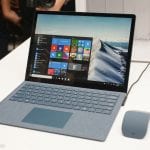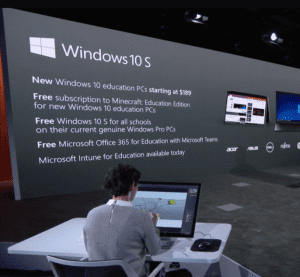 Having more than made the grade in enterprise, cloud computing, office productivity, and gaming software, Microsoft has learned some important lessons about go-to-market hardware as well as code.
Having more than made the grade in enterprise, cloud computing, office productivity, and gaming software, Microsoft has learned some important lessons about go-to-market hardware as well as code.
Meet the company’s newest graduate. The new Surface Laptop computer warrants a closer examination by students who want more power than a tablet but at a price point they can afford.
If you pick up a history book, Microsoft laptops and software once held a princely place in the primary education classroom. That was often alongside the Apple iPod, iMac and ultimately the iPhone. But it was before Google’s low-cost Chromebooks came along. With minimal licensing fees, Google Chrome was able to outflank a bevy of similar portables to create a laptop that could compete in processing power and power consumption.
At its debut EDU event in NYC, Microsoft resurfaced with the new Surface Laptop running a new form of Windows software called 10 S. The new Windows 10 S operating system should not be mistaken for Microsoft RT. This is an entirely new engine optimized for networking as well as more processor-intensive 3D rendering.
 The $999 Surface Laptop is a clamshell device, a true laptop unlike the Surface Book 2-in-1. It uses a 13.5-inch PixelSense display with a 3:2 aspect ratio. “This is the thinnest LCD touch model ever created and put into a laptop,” said MS Device Chief, Panos Panay, complete with 3.4 million pixels. The screen even supports Microsoft’s Surface Pen, so you can draw on the display just like other Surface devices.
The $999 Surface Laptop is a clamshell device, a true laptop unlike the Surface Book 2-in-1. It uses a 13.5-inch PixelSense display with a 3:2 aspect ratio. “This is the thinnest LCD touch model ever created and put into a laptop,” said MS Device Chief, Panos Panay, complete with 3.4 million pixels. The screen even supports Microsoft’s Surface Pen, so you can draw on the display just like other Surface devices.
At the moment, version 10 S can only install third-party apps from Microsoft’s Windows store. This brand uniformly impressed school administrators who fell for its simplicity.
 Can Surface unseat the Chromebook as the top choice for schools, with more than 20 million students using the laptops internationally, according to Google? For those looking for an alternative to Chrome, the sleek Surface Laptop, living within the Microsoft ecosystem, may more than fill the gap.
Can Surface unseat the Chromebook as the top choice for schools, with more than 20 million students using the laptops internationally, according to Google? For those looking for an alternative to Chrome, the sleek Surface Laptop, living within the Microsoft ecosystem, may more than fill the gap.
The new Surface Laptop won’t be the only device running Windows 10 S. Acer and HP are both offering cheaper options for schools that might not want to shell out $1,000 for the premium device.
Introducing Virtual/Augmented Reality
With its experience as a kinetic gaming and 3-D leader in the home, Microsoft has taken its knowledge into new realms of simulated virtual and augmented reality. The company has announced there will be at least 7 million new jobs for creating 3D art in North America alone.
Microsoft will also be partnering with Pearson Education to bring 3D and MR devices into classroom curriculum by 2018. The packages will include subjects like history, science, math and commerce.
Microsoft is starting preorders for the Surface Laptop today, priced starting at $999 for the Core i5 version with 4GB of RAM and 128GB of SSD storage. The Surface Laptop will start shipping on June 15th. It will cost $49 to upgrade from Windows 10 S to the full Windows 10 Pro. The change allows people to download software that is not curated and secured by Microsoft. [24×7]



















